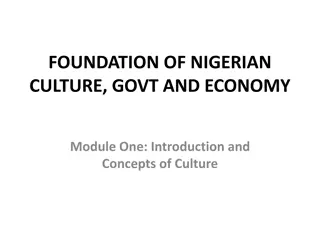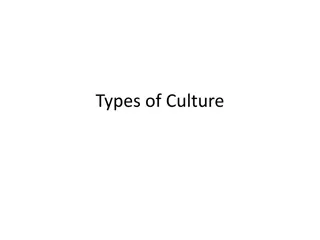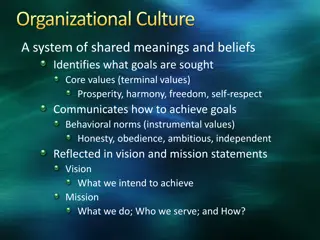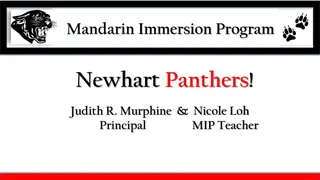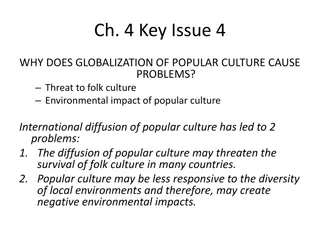Cultivating a Successful Culture in Neurology Department
Importance of culture in a neurology department highlighted by Dr. Robin L. Brey. Emphasis on how culture trumps strategy and the role of leaders in maintaining a positive culture. Examples and insights on how culture influences decision-making and behavior. Attributes of a successful culture and how it impacts organizational outcomes and employee satisfaction. Characteristics of a successful culture described in detail based on Harvard Business Review concepts.
Download Presentation

Please find below an Image/Link to download the presentation.
The content on the website is provided AS IS for your information and personal use only. It may not be sold, licensed, or shared on other websites without obtaining consent from the author. Download presentation by click this link. If you encounter any issues during the download, it is possible that the publisher has removed the file from their server.
E N D
Presentation Transcript
Creating a Successful Culture in a Department of Neurology Robin L. Brey, MD Professor and Chair Edna Smith Dielmann Distinguished University Chair Department of Neurology UT Health San Antonio
Importance of Culture Culture eats strategy for Breakfast Lunch Dinner Maintaining an effective culture is so important that it, in fact, trumps even strategy (Howard Stevenson)
Strategy and Culture Strategy offers a formal logic for an organization s goals and orients people around them Culture expresses goals through values and beliefs, and guides activity through shared assumptions and group norms Leaders are responsible for both
Influence of Culture Culture Guides discretionary behavior Dictates how to respond Whether to risk telling bosses about new ideas or problems. Shapes how decisions are made when leadership in not in the room
Influence of Culture Example: Johnson & Johnson 1982 7 people in Chicago dead because of Extra- strength Tylenol laced with cyanide Against legal and law enforcement advice initiated a national recall of all Tylenol products (at a cost of $100 million) We believe that our first responsibility is to doctors, nurses and patients; to mothers and fathers and all others who use our products and services
Why Culture Is Important Aligned with strategy and leadership, a successful culture drives positive organizational outcomes Successful cultures have three compelling attributes: 1. They consistently produce outstanding results 2. They attract, motivate and retain top talent 3. They successfully adapt to changing conditions
How do People Feel in a Successful Culture? Free to be themselves Understand what is really going on Strengths are recognized and they have opportunities to grow Things are fair and transparent Proud to work in the organization Work is meaningful Not hindered by stupid rules Goffe and Jones. Harvard Business Review;May 2013.
Factors that Hinder a Successful Culture Poor communication Toxic Employees/Bosses (The No Asshole Rule Robert Sutton) Focus solely on profit/results Leadership resistance to change Performance management
Costs of an Unsuccessful Culture Health care expenditures nearly 50% higher Engagement in work negatively impacted 37% absenteeism 16% lower profitability 37% lower job growth Lack of loyalty Increase in voluntary turn-over of 50% Higher rate of workplace harassment Seppala and Caneron. Harvard Business Review; Dec 2015.
Developing a Successful Culture: Leadership Responsibilities Organizations are lengthened shadows of their leaders -Ralph Waldo Emerson
Developing a Successful Culture: Questions for Leaders Do you take culture seriously? Do you understand and monitor your culture? Do you use culture as a way to communicate values and strategy? Are you investing adequately in the people on your team?
Do the times make the leader or does the leader make the times? 1. Acknowledge when failed policies demand change in direction 2. Anticipate contending viewpoints 3. Know when to hold back and when to move forward 4. Set an example 5. Understand the emotional needs of the team 6. Refuse to let past resentments fester 7. Control angry impulses 8. Protect colleagues from blame 9. Keep your word 10. Gauge sentiment 11. Establish trust Leadership in Turbulent Times Doris Kearns Goodwin
How Do You Shape Culture? Begin by understanding your organization s culture (and sub-cultures) Understand what type of culture is needed to advance your organization s strategies and goals
Cultural Profile Instrument The Organization Is Focused On The Organization Feels Like Cultural Dimension Collaboration and Mutual Trust A Big Family Caring Compassion and Tolerance An Idealistic Community Purpose Exploration and Creativity A Dynamic Project Learning Fun and Excitement A Celebration Enjoyment Achieving and Winning Strength and Boldness A Meritocracy A Competitive Arena Results Authority Planning and Caution A Meticulously Planned Operation A Smoothly Running Machine Order Safety Structure and Stability Groysberg et al. Harvard Business Review;Jan-Feb 2018.
Culture Styles Culture Style Advantages - Improves Disadvantages Overemphasis on: CARING Teamwork, trust, engagement, communication Consensus-building reduces exploration of options, slows decision-making PURPOSE Appreciation for diversity and social responsibility Long-term purpose may get in the way of practical and immediate concerns LEARNING Improved innovation and agility Exploration may lead to lack of focus and inability to exploit existing advantages ENJOYMENT Employee engagement, morale, and creativity Autonomy may lead to lack of discipline and compliance and governance issues RESULTS Execution, external focus and goal achievement Results may led to stress, anxiety, communication and collaboration breakdowns AUTHORITY Decision making speed and responsiveness to threats Strong authority may lead to politics, conflict, psychological safety SAFETY Risk management and stability Standardization may lead to inflexible and dehumanized work environment ORDER Operational efficiency and reduced conflict Rules and tradition may reduce individualism, creativity and agility
UT Health San Antonio Neurology Results Cultural Dimension: Advantage All Faculty Residents Admin Staff Clinical Staff Caring: Teamwork, trust, engagement, communication 2 2 1 Purpose: Appreciation for diversity and social responsibility 1 1 3 1 1 Learning: Innovation, agility, organization changes in response to mistakes 2 3 Enjoyment: Playful, instinctive, improved morale Results: Improved execution, external focus and goal achievement 2 3 Authority: Improved decision making speed and responsiveness to threats Safety: Improved risk management and stability 3 4 3 4 4 2 4 Order: Improved operational efficiency and reduced conflict 4
UT Health San Antonio Department of Neurology Values We respect and value all three academic missions realizing that it takes all of us working as a team to accomplish our goals (Caring - #2) We treat everyone we work with and provide care for as we ourselves would want to be treated (Caring - #2) We strive to make our department among the top places in which to work, learn and receive care (Results ranked only by staff) Survey results: #1 Purpose; #2 Caring; #3 Learning; #4 Order
UT Health San Antonio Department of Neurology Vision (All Results Oriented) Clinical: Clinical services sought after locally, regionally and nationally for providing the highest quality of care Education: Highest caliber educational experiences for medical students Outstanding residency and fellowship training that prepares trainees for the future practice of neurology Research: Known nationally and internationally for the breadth and depth of neuroscience research Faculty Development: All faculty members are successful no person left behind!
Shaping Culture Articulate the aspiration Understand what outcomes the culture produces Aspire to develop a culture that aligns with mission and goals Select and develop leaders who align with the target culture Begin with yourself Consistently demonstrate characteristics of the desired culture Use organizational conversations about culture to underscore the importance of change Encourage and create opportunities for meaningful dialog Clearly link culture to tangible goals Reinforce the desired change through organizational design Organizational structure can have a profound impact over time on how people think and behave within an organization Groysberg et al. Harvard Business Review;Jan-Feb 2018.
Shaping Culture Build Safety You are part of this team This team is special; we have high standards here I believe you can reach those standards Share Vulnerability Does anyone have any good ideas? Establish Purpose Name and rank priorities Communicate broadly The Culture Code Daniel Coyle




